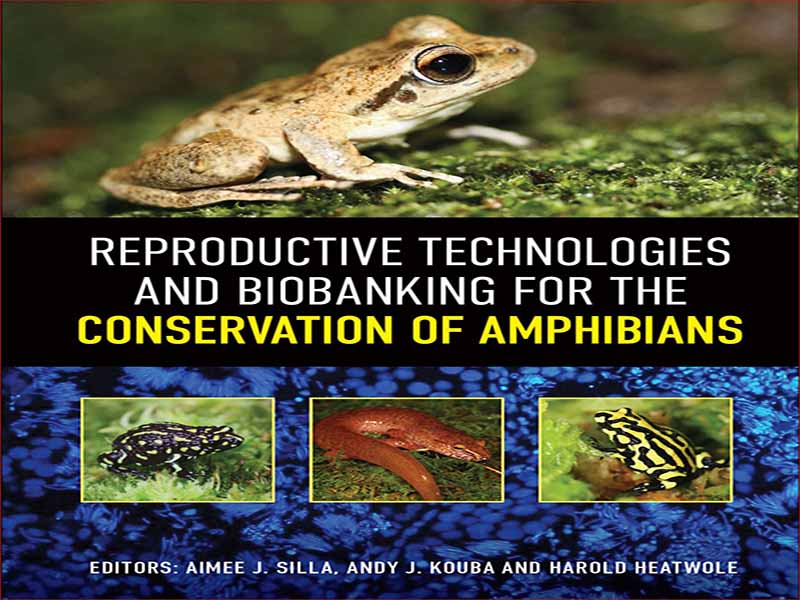- عنوان کتاب: REPRODUCTIVE TECHNOLOGIES AND BIOBANKING FOR THE CONSERVATION OF AMPHIBIANS
- نویسنده: Harold Heatwole
- حوزه: دوزیستان
- سال انتشار: 2022
- تعداد صفحه: 249
- زبان اصلی: انگلیسی
- نوع فایل: pdf
- حجم فایل: 6.45 مگابایت
این کتاب جلد 12 از مجموعه زیست شناسی دوزیستان است که تمام جنبه های زیست شناسی این گروه جذاب از مهره داران را پوشش می دهد. جلدهای 8 و 10 به حفاظت از دوزیستان به صورت موضعی می پردازد و جلدهای 9 (نیمکره غربی) و 11 (نیمکره شرقی) تهدیدات دوزیستان و وضعیت کاهش و حفاظت از آنها را بر اساس کشور به کشور بررسی می کنند. . مناطق فرعی مختلف در شماره های جداگانه (قسمت) جلدهای 9 و 11 بررسی شدند. در حال حاضر پوشش آمریکای جنوبی، آسیا، آفریقا و اروپا کامل شده و منتشر شده است. موضوعی برای جزایر کارائیب در حال چاپ است. دو شماره، یکی خاور نزدیک و دیگری آمریکای مرکزی و مکزیک در حال آمادهسازی هستند، و تنها ایالات متحده و کانادا باقی میمانند که در مجموع جلد 9 منتشر شوند.
دوزیستان، با پوست نفوذپذیر، تنفس پوستی و وابستگی به آب، به ویژه نسبت به آلودگی، خشک شدن، و تکه تکه شدن و از بین رفتن زیستگاه حساس هستند و این مجموعه تهدیداتی را که آنها در دنیایی که در آن ناپایداری آب و هوایی پدیدار می شود، برجسته کرده است. بیماری های جدید، و جمعیت رو به رشد انسانی، همراه با حمله به جهان طبیعی، موجودیت موجودات جهانی را تهدید می کند. دوزیستان احتمالاً بیشترین آسیب را در بین مهرهداران داشتهاند و بیشترین نیاز را به تحقیقات اختصاص داده شده برای حفظ آنها و جلوگیری از انقراض عظیم دارند. کتابخانه فوق بیشتر جنبه های این موضوع را پوشش داده و پیشرفت قوانین حمایت از دوزیستان را بررسی کرده است. کنار گذاشتن پناهگاه ها؛ گسترش بیماری های اضطراری؛ اشتغال پرورش در اسارت؛ ارزیابی تهدیدات و طبقه بندی درجات تهدید برای انواع گسترده ای از گونه ها. و همچنین جنبه های مربوط به طبقه بندی، تاریخ طبیعی، و توزیع دوزیستان. با این حال، چندین گیاه شناس برای من بر لزوم ارائه راهنمای روش عملی برای ربودن گونه های در معرض خطر انقراض دوزیستان از لبه انقراض تاکید کرده اند. در سالهای اخیر، تحقیقات در مورد این موضوع سرعت بیشتری گرفته است، زیرا نیاز به آن ضروریتر شده است، و بررسی این اطلاعات جدید به نفع دانشمندانی که وارد این حوزه میشوند، برای مقامات دولتی درگیر در حفاظت، و برای عموم مردم ضروری شده است. عمومی. برنامه های اصلاح نژاد در اسارت در برخی از فصول ارزیابی های کشور به کشور مورد بحث قرار گرفت، اما بانک زیستی و ایجاد مخازن برای ژرم پلاسم پوشش داده نشده است. به عنوان یک رویکرد در حال ظهور، به موقع است که مروری بر این موضوع مهم منتشر شود.
نهمین کنگره جهانی هرپتولوژی در دانشگاه اوتاگو در نیوزیلند در ژانویه 2020 توسط فیل بیشاپ فقید به عنوان آخرین مشارکت برجسته او در هرپتولوژی برگزار شد. این فرصت را برای به ثمر رساندن رویکردهای فوق فراهم کرد. دو سردبیر ارشد این جلد، ایمی سیلا و اندرو کوبا، سمپوزیومی را برای کنگره با عنوان «بیوتکنولوژی های تولیدمثلی و بانکداری زیستی برای حفاظت از دوزیستان» ترتیب دادند. بسیاری از مبتکران و دست اندرکاران روش های جدید برای تکثیر دوزیستان در اسارت و بازگرداندن موفقیت آمیز آنها به حیات در طبیعت، در آن سمپوزیوم شرکت کردند و دام هایی را برای اجتناب از آنها آشکار کردند و دستورالعمل هایی را برای دستیابی به نتایج مطلوب ایجاد کردند. مقالاتی که ارائه شد و بحثهای اکتشافی پس از آن، بذری را تشکیل داد که جوانه زد و در کتاب حاضر گل داد. امید است که این شروع ساده با افزایش تعداد مؤسسات درگیر در این تلاش به مؤسساتی که قبلاً برنامه های فعالی داشتند (به ضمیمه انتهای این کتاب مراجعه کنید) تحقیقات بیشتر و مؤثرتر را تحریک کند و همکاری سنتی را تحریک کند. و فنآوریهای نوظهور، برای حفاظت بهتر و ماندگارتر از جانوران دوزیستان گرانبهای زمین.
This book is Volume 12 in the series Amphibian Biology, which covers all aspects of the biology of this fascinating group of vertebrates. Volumes 8 and 10 dealt with conservation of amphibians on a topical basis, and Volumes 9 (Western Hemisphere) and 11 (Eastern Hemisphere) examined the threats to amphibians and the status of their decline and conservation on a country-by-country basis. Different subregions were treated in separate issues (Parts) of Volumes 9 and 11. At present the coverage for South America, Asia, Africa, and Europe is complete and has been published; an issue for the Caribbean islands is in press; two issues, one covering the Near East and the other covering Central America and Mexico are in preparation, leaving only the United States and Canada to be launched in a combined Part of Volume 9.
Amphibians, with their permeable skins, cutaneous respiration and dependence on water are especially sensitive to pollution, desiccation, and the fragmentation and loss of habitat, and the series has highlighted the threats they face in a world in which climatic instability, emerging new diseases, and a burgeoning human population, with its attendant assault on the natural world, threaten the very existence of the global biota. Amphibians arguably have suffered the greatest of any vertebrate taxon, and the one most in need of research dedicated to their conservation and the prevention of massive extinction. The above library has covered most aspects of this topic and has reviewed the progress of legislation protecting amphibians; the setting aside of refuges; the spread of emergent diseases; the employment of captive breeding; assessment of the threats and classifying the degrees of threat to a wide variety of species; as well as the relevant aspects of the taxonomy, natural history, and distribution of amphibians. Several herpetologists, however, have stressed to me the need to provide a guide to the practical methodology for snatching endangered species of amphibians from the brink of extinction. In recent years, research on this topic has accelerated as the need for it has become more urgent, and it became imperative to review this new information for the benefit of scientists entering this field, for public officials involved in conservation, and for the public in general. Captive breeding programs were discussed in some of the chapters in the country-by-country assessments, but biobanking and the establishment of repositories for germplasm have not been covered. As an ever-increasing emerging approach, it is timely to publish a review of this important topic.
The 9th World Congress of Herpetology was convened at the University of Otago in New Zealand in January 2020, by the late Phil Bishop as the last of his many outstanding contributions to herpetology. It provided the opportunity for the fruition of the above approaches. The senior two editors of this volume, Aimee Silla and Andrew Kouba, organised a symposium for the Congress entitled ‘Reproductive Biotechnologies and Biobanking for Amphibian Conservation’. Many of the innovators and practitioners of new methods for propagating amphibians in captivity, and successfully returning them to viability in nature, participated in that symposium, and exposed pitfalls to avoid and created guidelines to use for achieving the desired results. The papers that were presented, and the heuristic discussions that followed, constituted the seed that germinated and flowered into the present book. It is hoped that this modest beginning will stimulate further, and more effective, research by increasing the number of institutions involved in this endeavour to those already with active programs (see the Appendix at the end of this book) and stimulate collaboration of traditional and emerging technologies, for a better and more enduring conservation of earth’s precious amphibian biota.
این کتاب را میتوانید از لینک زیر بصورت رایگان دانلود کنید:
Download: REPRODUCTIVE TECHNOLOGIES AND BIOBANKING FOR THE CONSERVATION OF AMPHIBIANS




































نظرات کاربران